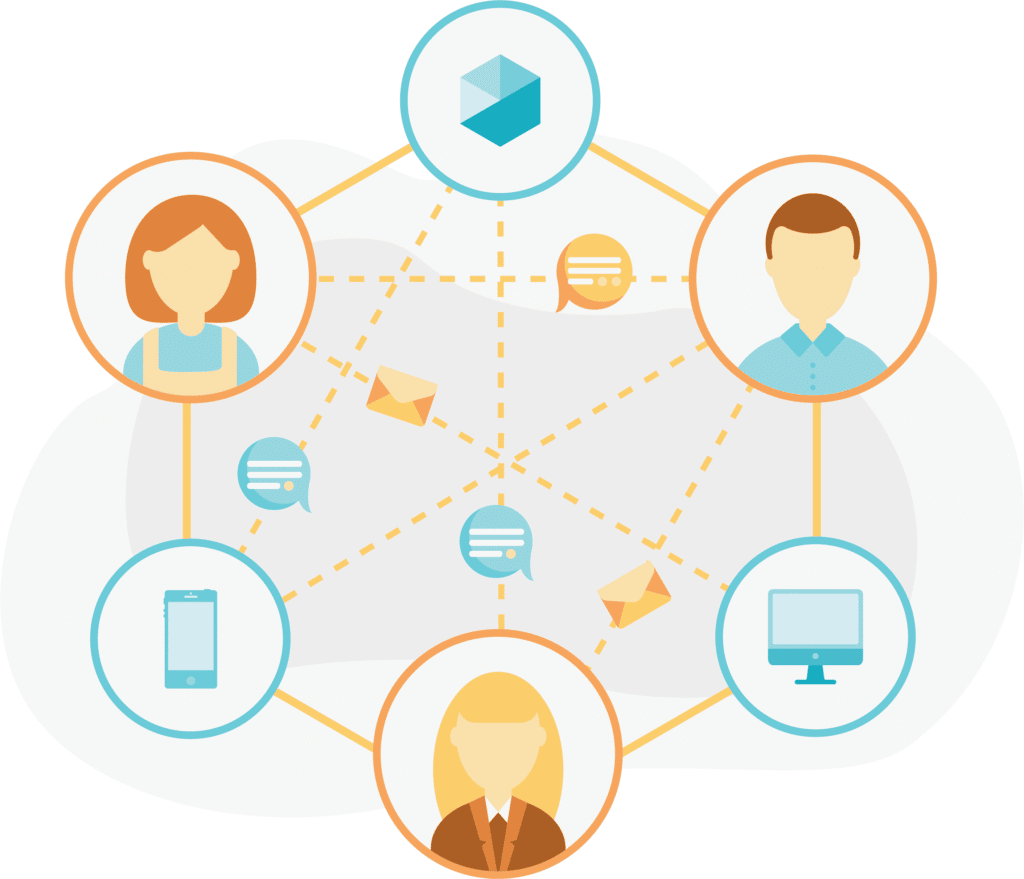As companies expand across different departments, buildings, and even continents to reach a global client base, it becomes increasingly more challenging to overcome workplace hierarchy. Correspondence between top management and non-desk workers is minimal, but it doesn’t have to be that way with the digital workplace.
Traditionally, the hierarchy of workplace communication is top down—leaders and managers disseminate information and lead the conversation. When companies buy into a digital workplace, it suddenly flattens the workplace hierarchy by giving every employee the tools to participate in company dialogue.
This bottom-up leadership strategy is a better approach to internal communication and leads to better business outcomes.
- There is a larger diversity of voices represented and new ideas generated
- Opens up the workflow to collaboration which leads to greater innovation
- Builds a culture of inclusivity which leads to higher retention
- Delegating responsibilities over a mobile app empowers employees
Here are ten ways to help foster a connection between executives and their staff and create a more successful company employee hierarchy.
1. Adopt a Mobile-First Communication Tool
To include every employee in company communication, the internal communication tool you choose must be centered around a mobile component. This means the entry point is through an app that employees download onto their mobile device.
This creates an equal opportunity for every employee, especially mobile workers, to connect, participate, and communicate.
2. Flatten Communication Hierarchy with Open Communication Channels
Management, especially executive management, often seems inaccessible—like the great and powerful Oz behind his big green curtain. Although globalization makes connecting with executives appear impossible, enterprise messaging and other internal communication platforms have opened the doors to open dialogue between office workers, frontline employees, and management alike.
Knowing how to overcome communication gaps between these types of workers can be surprisingly simple with a team communication app and a thoughtful internal communication strategy in place. Create a transparent dialogue that reaches your entire staff by extending messaging to everyone and opening up communication channels that you once used for leadership teams.
Pro tip: Create a communication stream dedicated to introductions and ask every employee to chime in and introduce themselves to their colleagues!
3. Lead by Example
When you open up communication channels to everyone, your employees might be shy about jumping into the dialogue. Lead by example and demonstrate two things: that it’s okay to initiate conversations as well as your app’s capabilities.
The simple act of posting a comment, liking someone else’s, or sending an employee survey enables visibility and makes the entire organization feel like one team.
4. Encourage Engagement to Get Employee Buy-In
Your internal communications approach is only as good as its reach. Here are ways you can encourage adoption of your employee app and kick-start enterprise-wide engagement in corporate communication

- Gamification: This play-based approach to communication might sound like an elementary idea, but gamification is an effective strategy for encouraging participation. For example, create teams by department and see which manager can get the most employees onboard and engaged.
- Make it personal: Reach out to individual employees through direct messaging. Ask questions that encourage employees to reply. This one-on-one connection is a communication hierarchy example that makes an employee feel valued and appreciated.
- Ask for Feedback: Use your mobile communication tool’s survey feature to poll employees about a new policy or things they’d like to see done differently. It’s a way to get employees to dip their toe into the internal communications pool.
5. Recognize Employees and Celebrate achievements
This is a simple strategy that is often overlooked by leaders. Recognize individual employees for a a job well done. Putting the spotlight on an employee builds engagement and it encourages other employees to jump on the recognition bandwagon and add their comments.
6. Have a Multi-Channel Communication Strategy
An internal communication strategy should offer several ways for employees to connect. While it should be centered around a mobile platform that reaches every employee on their smart device, multiple channels for employees to participate to encourage a flattened hierarchy.
Reach out to employees through voice messaging, emails, direct messaging, chats. Adopt a communication app that enables these multiple ways so employees can find the method that is most comfortable for them.
Pro tip: Ask employees to contribute an article to your online newsletter so your communications content reflects multiple perspectives from all different levels of your company.
7. Crowdsource Ideas
Brainstorming ideas often takes place in meeting rooms at the leadership tier of a company. But this exclusive approach limits your company’s innovation.

The next time you need to come up with a strategy or product or way of doing something, ask your entire organization to submit ideas. When you find a few great ones, make those employees owners of their ideas and have them develop them further along with an internal mentor.
While this encourages enterprise-wide communication, it also benefits your company by creating new business ideas that could be profitable. It also spotlights employees who have great leadership potential within your company.
8. Create Growth Opportunities for Employees
Your employees are more likely to invest their time and energy into communication if they see there is potential growth within the organization.
Use your workforce app to create training opportunities that can upskill your workforce. For example, as manufacturing companies automate operations, many are using their digital workplace to train employees for new positions within the industry.
9. Build a Management Team Who Champion Inclusive Communication
With a growing global mobile workforce, estimated to grow to 1.87 billion by 2022, it’s hard for CEOs to connect with each and every one of those valuable workers. That’s where managers come in.
Building a strong, communication savvy management team can help create a more inclusive communication hierarchy.
Right now, fewer than 30% of your workers believe their managers value their opinions and ideas. It’s taking its toll on companies who are facing high, and expensive, turnover rates.
Managers can strengthen their relationship with their direct reports over a team app and flatten the communication hierarchy by:
- Create a regular back-and-forth feedback loop.
- Show gratitude and recognition to boost morale and inspire motivation. With digital workplace tools, you’ll have a vehicle to celebrate success stories and show appreciation.
- Face-to-face meetings with each employee
- Complement online communication with group meetings so employees can feel a part of the team and build important connections and friendships at work
10. Communicate with Transparency and Authenticity
Chances are you’ve heard this before but it’s worth reiterating—be transparent and authentic in your communication. This is the ultimate trust builder for any leader.
Being honest and open with information will inspire employees to champion the company’s mission and purpose. When you share information that might have once been reserved for management-level staff, ask employees for their thoughts.
Why? Because every employee in your organization has a different perspective and vantage point. This is especially true for customer-facing frontline teams who can provide insight that will help you make informed decisions that can benefit the bottom line.
Learn how to bridge the communication gap between executives, management, and every staff member with mobile team collaboration software.
Most Frequently Asked Questions
Bottom-up leadership strategy is a better approach to internal communication and leads to better business outcomes.
– There is a larger diversity of voices represented and new ideas generated
– Opens up the workflow to collaboration which leads to greater innovation
– Builds a culture of inclusivity which leads to higher retention
– Delegating responsibilities over a mobile app empowers employees







